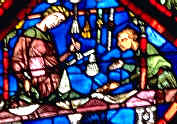
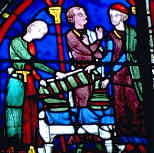

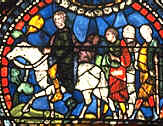



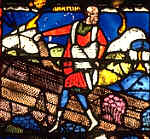
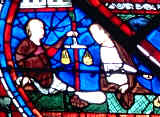

If you are looking at this page without frames, there is more information about medieval writing to be found by going to the home page (framed) or the site map (no frames).
| Weights, Measures and Money | |||||||
| Young scholars of today are used to everything going in tens. Decimal currency, kilograms, millilitres, kilometres and hectares. You donít have to go back to the middle ages to remember when school exercise books always had the back covers plastered with tables that helped you convert all sorts of apparently irrational measurements; pounds, shillings and pence; stones, pounds and ounces; furlongs, chains and yards; acres and perches. In fact, I remember them vividly. | |||||||
| However, while the relationships were a little chaotic, the actual quantities or measures were closely defined. This is not true of measurement in the medieval era, where even the quantities and the relationships between them could be somewhat variable. This can create enormous fun when dealing with something like medieval accounts. (See Zupko 1968, also Tillotson 1988, also Bagley 1972.) The following terms relate to English measures, but they give an idea of the scale of the problem. | |||||||
| In terms of weight, a pound usually contained 16 ounces, but sometimes 12. A stone was usually 14 pounds but this varied. A hundredweight was mostly 112 pounds but not always, and 20 hundredweights generally made a ton. |  |
||||||
| An apothecary weighs his wares in a stained glass window in Chartres cathedral. | |||||||
 |
In terms of length, 12 inches made a foot and 3 feet a yard, although one wonders just how precisely they were measured. An ell was supposedly 45 inches, which rather knocks on the head the theory that it was the distance from fingertip to elbow, and a rod was 5Ĺ yards. |
 |
|||||
| Two Chartres carpenters measure out their timber. | |||||||
| A Chartres draper measures out his cloth. | |||||||
 |
A mile was, if nothing else, very difficult to measure with medieval technology, but this was complicated by the fact that in some areas, notably the north, they used a long mile, which was longer. This idiosyncrasy persisted after the medieval era, to the consternation of 17th century travellers who ventured out of the home counties. | ||||||
| Pilgrims to Canterbury travel the miles, long and short, in a window in Canterbury Cathedral. | |||||||
 |
In liquid measure, 2 pints made a quart, 2 quarts made a pottle, 2 pottles made a gallon. A pipe was a large cask which held somewhere around 125 gallons and a tun was an even larger cask which held 2 pipes. A barrel was around 30 gallons, but this rather depended on whether it contained oil or packed fish. | ||||||
| A Chartres wine merchant transports his tun, or perhaps pipe. |  |
The fishmongers of Chartres have unpacked their barrels of fish. | |||||
| Measures of volume of dry products varied according to the product. For grain, 4 pecks made a bushel and 8 bushels made a quarter. (A quarter of what, one is tempted to ask?) A sarpler was a sack of wool, but if it was only half full it was called a poke. A chaldron was a measure of coal which might be 32 bushels or alternatively 48. Sheaves of grain were packed into bundles called thraves, which generally contained either 12 or 24 sheaves. |  |
||||||
| The Chartres baker empties his bushels of flour from their sack. | |||||||
 |
Things really start to become unhinged when we look at land area measurements. It seems that the underlying bases for such measurements were related to the value and ease of working of the land rather than a precise measurement of size, so that the units vary considerably. A carucate, hide or ploughland was originally an area of arable land which a plough team could keep in cultivation, but became a unit of tax assessment rather than an measure of area. Two bovates or oxgangs made a virgate and 4 virgates made a hide. These measures were highly variable. Virgates could range from 15 to 60 acres. The acre evidently was some sort of actual measure, and 4 roods made an acre. | ||||||
| A sower in a window at Canterbury Cathedral walks his oxgangs, or virgates. | |||||||
| Money was in pounds, shillings and pence, as until very recently. Twelve pence made a shilling and 20 shillings made a pound. However, when you could get the services of a labourer for a few pence a day, smaller units were needed. Four farthings made a penny, as did 2 halfpennies. The coin known as a groat was worth 4 pence. Just for a little extra numerological confusion, a mark was worth 13s.4d. or two thirds of a pound. | |||||||
| Coins, while being very significant and bearing the head of the king, were not purely symbolic. They had an actual precious metal value and must maintain their weight. Nasty punishments were meted out for clipping coins, or slicing the edges off to accumulate the precious metal. |  |
A Chartres banker weighs rather than counts his money. | |||||
 |
Two English medieval silver pennies. | ||||||
| Finally, to complete the confusion, the mere act of counting was not without its anomalies. Numbers were written in Roman numerals, which provides certain difficulties in computation. The Roman numeral C was generally used to represent 100, but sometimes 120, which is called a long hundred. The moral of all this is that any conclusions drawn from the analysis of quantity must have the backing of very careful checking of the measures involved. Makes you wonder how they did it without pocket calculators. | |||||||
| Still confused? Take a look at Hemyock Castle: Glossary of Ancient Weights and Measures. | |||||||
|
|
|||||||
|
|
|||||||
|
If you are looking at this page without frames, there is more information about medieval writing to be found by going to the home page (framed) or the site map (no frames). |
|||||||